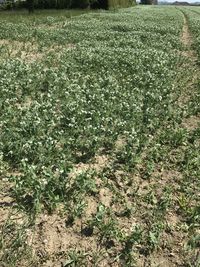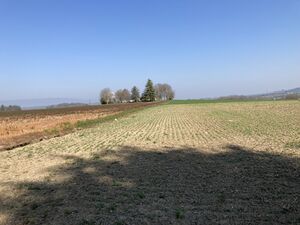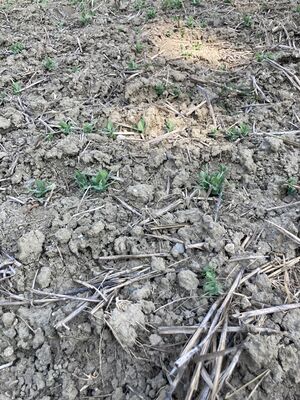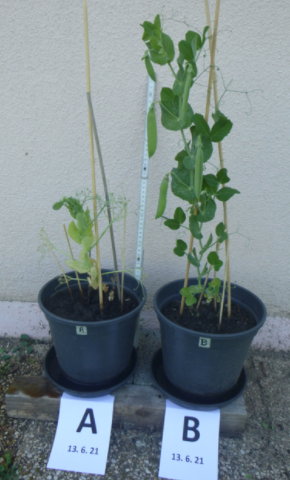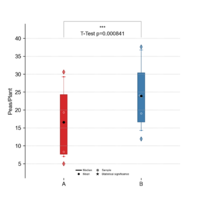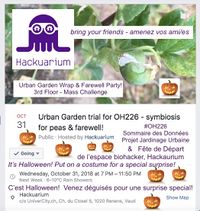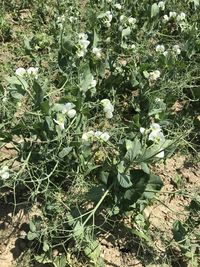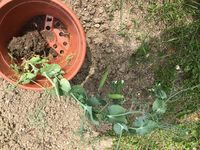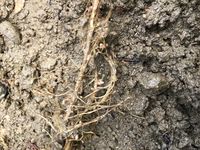Difference between revisions of "Urban gardens with rhizobial bacteria"
| (38 intermediate revisions by the same user not shown) | |||
| Line 1: | Line 1: | ||
| − | + | (à la [http://wiki.hackuarium.ch/w/Jardinage_urbain version française] - merci, Maurice! | |
| + | |||
| + | Up to March 2022, four annual trials for a project focussed on '''urban gardens with rhizobial bacteria''' have tested whether specific rhizobial bacteria will improve the growth of peas when used by ordinary people. <br> | ||
To note: such cultures are normally used on the agro-business scale! <br> | To note: such cultures are normally used on the agro-business scale! <br> | ||
| − | Here is [http://www.cilr.uq.edu.au/legume-information some basic info about such symbiosis for nitrogen utilisation] by plants.<br> | + | Here is [http://www.cilr.uq.edu.au/legume-information some basic info about such symbiosis for nitrogen utilisation] by plants. |
| + | |||
| + | Here is [https://gardenbetty.com/a-look-at-legumes-rhizobia-and-root-nodules/ another general explanation] of the topic...<br> | ||
| − | [[File:IMG 9589.jpg|200px|thumb|left|a pea field in Echandens]] | + | [[File:IMG 9589.jpg|200px|thumb|left|a pea field in Echandens]] [[File:Pea1.jpg|thumb|Echandens pea field 2022]] [[File:Pea1 closeup26mar22.jpg|thumb|no watering for peas in field.]] |
| − | The rhizobial strain needed for peas, ''Rhizobium leguminosarum Jordan'', was ordered from ATCC the first year and from Carolina.com the following year, after the frozen stocks did not seem happy after our move to Ecublens. It was grown with a special Rhizobium media, and used for controlled tests on symbiotic effects on pea harvests, comparing growth of inoculated and 'mock' inoculated pea plant sprouts. Our third trial was begun in the time of covid-19 and may have provided the best results to date. :)<br> | + | [[File:Mauricepeas.png|thumb|pots with big differences ...]] |
| + | The rhizobial strain needed for peas, ''Rhizobium leguminosarum Jordan'', was ordered from ATCC the first year and from Carolina.com the following year, after the frozen stocks did not seem happy after our move to Ecublens. It was grown with a special Rhizobium media, and used for controlled tests on symbiotic effects on pea harvests, comparing growth of inoculated and 'mock' inoculated pea plant sprouts. Our third trial was begun in the time of covid-19 and may have provided the best results to date. :) | ||
| + | |||
| + | However, the fourth run in 2021 was disappointing, with weather contributing to less results than expected and no chance for stat significance... <br> | ||
| + | <br> | ||
| + | UPDATE: In 2024, hopes to try again have been high, with a gardening group ('Les P'tites Pousses' of Echandens) also keen... until we found out that the rules for shipping the bacteria had changed! A -80 freezer is needed for our lab! Nothing really has happened post-pandemic... Even the fifth trial for 2022 was mainly controls - with a field in Echandens to follow - from treated seed already sown before Christmas 2021. | ||
| + | |||
| + | For the experiment to continue again, more involved members are necessary. Maybe this is for you? | ||
| + | |||
<br> | <br> | ||
| − | ''' | + | We only had two sign-ups confirmed as of the date of the General Assembly meeting in February 2022), to determine whether another experiment will be initiated. New media to grow the symbiotic culture was already tested, after a failure to get growth, even from the -80 gly stock at the UNIL DMF. In fact 3 attempts were made, and it was not a success. I need to get African violet soil again for the media! (the peat moss I tried this year did not make a happy culture...) |
| − | [[File:Pea per plant data.png|200px|thumb | + | |
| − | <br> | + | However, as there is a big pea field in Echandens, which is already being followed closely in 2022, we decided to make it a special control year. The field planted already before the end of 2021, with [https://www.farmkidblog.com/2016/04/20/why-are-your-seeds-pink/ bright pink seeds, which could mean] that they were treated with rhizobial cultures (or a fungicide)! We will try to find out more! |
| − | + | ||
| + | Such good growth as shown to right with no special care, is worth noting. | ||
| + | |||
| + | In lab we are germinating seeds, and people will be able to get A and B sets again, and we will see how the numbers come out! Could be interesting! | ||
| + | |||
| + | We hope to start distributing plants maybe even next Weds (but probably the week after)... | ||
| + | |||
| + | <br>It must also be acknowledged: | ||
| + | |||
| + | the fourth trial was unusual, with late snow and some striking but overall non-statistically significant results.''' <br>There were records broken, nonetheless, especially with 10 peas per pod! AND still peas to harvest (and some new flowers) in July 2021. An overall summary was again presented during the Fête de la Science et Biodiversité 2021 in Ferney-Voltaire FR. <br>=)<br>''' | ||
| + | Briefly, for the 2021 results, in addition, one hypothesis from the previous year about hydroponic conditions was refuted. We got better yields with 'fed' plants in seramis clay bits... The bacterial symbiosis really seemed to improve yields in 2021, in pots, especially, the conditions with rhizobial bacteria gave better harvests. However, too many plants died from the late frost for any real statistical confidence overall. Furthermore, in some gardens the plants that survived seemed to do even better without the rhizobial bacteria! | ||
| + | |||
| + | If you are interested please contact us (hello -at- hackuarium -dot- ch)!<br>Your interest will encourage us to do more! | ||
| + | |||
| + | |||
| + | The data on peas per plant in the garden from the 2020 round of the experiment did really seem significant; and the project was [https://youtu.be/fcvpJd-lev8 presented virtually (in French) for the 'Fête de la Science et de la Biodivérsite'] organised by our friends from Pangloss Labs (Ferney Voltaire, France), on 10oct2020<br> Here is a depiction of the data, on the right. (big thx, Vaios!) | ||
| + | [[File:Pea per plant data.png|200px|thumb]] <br> Here are more details for each participants' data, used to make the averages above.[[File:Individualcases_chartpeas2020.png|200px|thumb|left]] (The Y axis here is also 'peas per plant' and it should also be noted that the very low values from David B's crowded and shadowed garden were not included for the big averages shown above.) | ||
| + | <br> As can be seen from the results of 2020, the B conditions (with symbiotic bacteria) out in the garden soil gave the best harvests. '''However, if you would like to do a hydroponic urban garden, these bacteria are not at all recommended!'''! (see the far right side of the graph on the left side of this page, with individuals' results.)<br> | ||
Previous news: | Previous news: | ||
| Line 18: | Line 47: | ||
RA has to admit, it was the biggest pea harvest in her whole life... ! <br> | RA has to admit, it was the biggest pea harvest in her whole life... ! <br> | ||
| − | + | Plants grew well during this pandemic, and we can do more still to analyse all the data we have ... <br> | |
March, 2020 - 12 participants got plants for the current trial, in the time of covid-19. <br> | March, 2020 - 12 participants got plants for the current trial, in the time of covid-19. <br> | ||
Latest revision as of 11:17, 17 April 2024
(à la version française - merci, Maurice!
Up to March 2022, four annual trials for a project focussed on urban gardens with rhizobial bacteria have tested whether specific rhizobial bacteria will improve the growth of peas when used by ordinary people.
To note: such cultures are normally used on the agro-business scale!
Here is some basic info about such symbiosis for nitrogen utilisation by plants.
Here is another general explanation of the topic...
The rhizobial strain needed for peas, Rhizobium leguminosarum Jordan, was ordered from ATCC the first year and from Carolina.com the following year, after the frozen stocks did not seem happy after our move to Ecublens. It was grown with a special Rhizobium media, and used for controlled tests on symbiotic effects on pea harvests, comparing growth of inoculated and 'mock' inoculated pea plant sprouts. Our third trial was begun in the time of covid-19 and may have provided the best results to date. :)
However, the fourth run in 2021 was disappointing, with weather contributing to less results than expected and no chance for stat significance...
UPDATE: In 2024, hopes to try again have been high, with a gardening group ('Les P'tites Pousses' of Echandens) also keen... until we found out that the rules for shipping the bacteria had changed! A -80 freezer is needed for our lab! Nothing really has happened post-pandemic... Even the fifth trial for 2022 was mainly controls - with a field in Echandens to follow - from treated seed already sown before Christmas 2021.
For the experiment to continue again, more involved members are necessary. Maybe this is for you?
We only had two sign-ups confirmed as of the date of the General Assembly meeting in February 2022), to determine whether another experiment will be initiated. New media to grow the symbiotic culture was already tested, after a failure to get growth, even from the -80 gly stock at the UNIL DMF. In fact 3 attempts were made, and it was not a success. I need to get African violet soil again for the media! (the peat moss I tried this year did not make a happy culture...)
However, as there is a big pea field in Echandens, which is already being followed closely in 2022, we decided to make it a special control year. The field planted already before the end of 2021, with bright pink seeds, which could mean that they were treated with rhizobial cultures (or a fungicide)! We will try to find out more!
Such good growth as shown to right with no special care, is worth noting.
In lab we are germinating seeds, and people will be able to get A and B sets again, and we will see how the numbers come out! Could be interesting!
We hope to start distributing plants maybe even next Weds (but probably the week after)...
It must also be acknowledged:
the fourth trial was unusual, with late snow and some striking but overall non-statistically significant results.
There were records broken, nonetheless, especially with 10 peas per pod! AND still peas to harvest (and some new flowers) in July 2021. An overall summary was again presented during the Fête de la Science et Biodiversité 2021 in Ferney-Voltaire FR.
=)
Briefly, for the 2021 results, in addition, one hypothesis from the previous year about hydroponic conditions was refuted. We got better yields with 'fed' plants in seramis clay bits... The bacterial symbiosis really seemed to improve yields in 2021, in pots, especially, the conditions with rhizobial bacteria gave better harvests. However, too many plants died from the late frost for any real statistical confidence overall. Furthermore, in some gardens the plants that survived seemed to do even better without the rhizobial bacteria!
If you are interested please contact us (hello -at- hackuarium -dot- ch)!
Your interest will encourage us to do more!
The data on peas per plant in the garden from the 2020 round of the experiment did really seem significant; and the project was presented virtually (in French) for the 'Fête de la Science et de la Biodivérsite' organised by our friends from Pangloss Labs (Ferney Voltaire, France), on 10oct2020
Here is a depiction of the data, on the right. (big thx, Vaios!)
Here are more details for each participants' data, used to make the averages above.
(The Y axis here is also 'peas per plant' and it should also be noted that the very low values from David B's crowded and shadowed garden were not included for the big averages shown above.)
As can be seen from the results of 2020, the B conditions (with symbiotic bacteria) out in the garden soil gave the best harvests. However, if you would like to do a hydroponic urban garden, these bacteria are not at all recommended!! (see the far right side of the graph on the left side of this page, with individuals' results.)
Previous news:
Some participants even examined nodules. but... will differences seen be significant?
Will any of the results stand the test of statistics with good data only from 8 participants (partial data for 2 more, and basically none at all for 2 participants.)
RA has to admit, it was the biggest pea harvest in her whole life... !
Plants grew well during this pandemic, and we can do more still to analyse all the data we have ...
March, 2020 - 12 participants got plants for the current trial, in the time of covid-19.
Their data will be subjected to its first big public scrutiny soon...
Older news: 28.4.19 Pea plants were given out for the second trial, in spite of the disappointment of very little growth over the last week in the big trays...
The best looking plants (just 8 of each group A and B) were the ones grown in the lab!! We may need to channel our inner Gregor Mendel this year, and hope for better the next?!! Some participants are getting 2 plants each, and others 4 plants each of the test groups 'A' and 'B'! Some better weather is finally forecast!
Here is a new wiki page for this second edition of the project.
Older news: 25.4.19 - the kick-off info event for the 2nd round of the project was held 22 May during the #OH evening.
Only four people showed up, but there were already 5 people keen to get some plants and follow their growth!
- The meeting about the 1st year's data last fall (after a world record late harvest of sweet peas!) came to the conclusion that... drumroll --and in spite of low rates of responses by participants-- it is ... indeed worth doing more testing.
This is the prezi used for the 31oct summary during the farewell party
Still older news: 25 October, a summary of the data obtained in this first urban garden trial was be presented for #OH226, the 31st of October
!
This Open Hackuarium also provided the occasion for a farewell party for Hackuarium, which already moved its lab equipment from the Renens site, and was still looking for its new 'chez nous' to set up with the new cooperative (including Octanis and others)!!
Come join us!
previous news: 20 October, none of the pods on the plants seem to be developing further outdoors. (With temps below 10oC, some days, not very surprising)
old news: 1 October, some pods were harvested, and 15 october even more... Could this urban garden trial be the world record for pea harvests outdoors, in such a season?
old news: 27 Sept: Most participants' pots are not doing so well, but some are still growing, and (surprise!) there have even been flowers and actual pea pods on many plants in people's gardens! Will we have a record late pea harvest (already in Fall!)?? The big wrap event for the project was still planned for 31Oct!
The google drive for the data from participants is organised, so everyone can add info to a spreadsheet (the more numbers the better - one participant is already measuring average heights of the plants in his pots) and post images of their plants. The minimal requirement is one picture per week, and counting all the pea pods, but the more numbers we can get, the better. Everyone also needs to try to make sure the plants from the 2 pots get as close to the same conditions as possible, for light, water etc. but can keep them in the pots or put them in the garden, as they like. Hoping for a good harvest!
Watch this space!
More will come soon, and new pages... TRANSLATORS REQUESTED! ( all the below is being left for historical purposes)
Two germination trays and a new set of pea seeds (for late season planting!) are ready.
Half of the seeds will be sprouted in the tray with no inoculum, and half in a tray also containing the special bacteria.
(conc to be decided still)
We are still following these recommendations but will not simply soak the peas overnight, but rather put them on paper towels for the initial germination before inoculation. Half of these seeds will be inoculated with the symbiotic bacterial strain before putting them into the soil in germination trays.
The other half will be 'mock inoculated' with a bit of the culture media. The soil for sprouting in the trays will be autoclaved again (and is 'bio'), for the germination, but participants decide and document what they do with the baby plants subsequently...
Of course, watering and pictures are highly recommended!
First, percentage of germination for both trays will be quantitated (hoping there is no special effect of the inoculum!).
Then, we will pass on plants to our recruits (trial participants) that have home gardens (potager) or even just balcony space, potentially, and are willing to document the growth of their seedlings.
Ideally, the participants will take about a dozen of each sprout (inoculated and control, coded, however, so they don't know which group is which), and after a few weeks of growth we will have them look closely at roots for maybe 2 plants of each batch, trying to quant number of nodules per cm of root... (for example)
Care will need to be taken in this process, so hopefully there won't be damage to the plants, but as long as more than 5 remain undisturbed and grow until harvest, we should be in ok shape...
Additionally, the number of plants to adulthood (making flowers, making a pea crop) will be scored, then finally number of pods and number of peas will be also obtained.
From 10 plants (or 12 in cases where the nodule counts don't ruin everything - if care taken, reportedly possible) we could get a good idea about how effective the treatment was from these numbers.
How many seeds in packet? about 100 - did two packages
How many people are interested?
Several signed on at the #OH200, 2May.
What do they take them home in? in pots...
to keep identities 'blind' decided to just label the two groups A or B, and the secret code (for inoculated or mock-inoculated) won't be revealed until the very end of the expt (grand recap planned for 31oct18)!
---
If possible, soils might be saved and used for 2nd test (?? just from resid plants in initial tray tests) for long term fertility for a second crop (non-legumous, tomatoes?).
---
There is some good background information here about how important the correct rhizobial bacteria in nodules are for nitrogen fixing... (in the context of peanuts, however, which symbiose with a different bacterial species)
Here is some more inspirational citizen science - a monoculture vs polyculture experiment.
